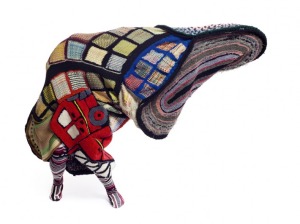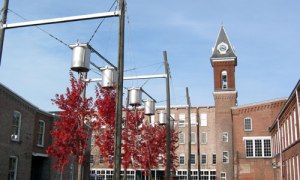It’s difficult to craft a logical response to something as inconsistent and unreasonable as Camille Paglia’s recent Wall Street Journal essay “How Capitalism Can Save Art.” But, when links to the piece ended up in my Facebook feed this week, I knew I had to give it a shot. Paglia concludes that “our fine arts have become a wasteland”due to our country’s shrunken industrial base and the “routine defamation of capitalism by armchair leftists.”
Her thesis is flawed from the start. She declares,
Performance genres like opera, theater, music and dance are thriving all over the world, but the visual arts have been in slow decline for nearly 40 years. No major figure of profound influence has emerged in painting or sculpture since the waning of Pop Art, and the birth of Minimalism in the early 1970s.
In addition to limiting the visual arts to painting and sculpture, completely dismissing film, video, drawing, printmaking, photography and performance, Paglia is wrong in her assertion that there have been no major, influential artists in the past 4 decades. I can name dozens, including this diverse group of twelve: Ai Weiwei, Marina Abramovic, Kiki Smith, William Kentridge, Sarah Sze, Kara Walker, Takashi Murakami, Mickalene Thomas, Natalie Jeremijenko, Damien Hirst, Chuck Close and Jeff Koons. Although I personally enjoy the work of some of these artists more than others, I can say with certainty that each has made important and effective work. And while these names may not have the average household recognition of Michelangelo or Claude Monet, neither do Frank Gehry or Rem Koolhaas, whom Paglia sites as examples of individuals making “work of bold originality and stunning beauty” in the “frankly commercial” field of architecture. Indeed, I’m not familiar with any contemporary opera singers, theater directors, classical musicians or ballet dancers, but I wouldn’t use my ignorance as evidence against Paglia’s assertion that these genres are “thriving all over the world.” I’d also be hard pressed to name a contemporary pro-soccer player, but my brother-in-law assures me that the sport is, in fact one of the world’s most popular pastimes. Perhaps Paglia is unable to conjure the name of a contemporary, influential artist (disturbing, as she’s on faculty at Philadelphia’s University of the Arts), but this hardly means that there are none.
Paglia’s rant is filled with unsubstantiated claims of the anti-capitalist agenda of arts faculty and academics. In fact, arts business courses are routinely included in arts curriculum. Jackie Battenfield, the author of The Artists Guide: How to Make a Living Doing What You Love is on faculty at Columbia University School of the Arts. The School of Visual Arts MFA Art Practice program, for which I work, includes required courses in Art Law and Art Business. Rutgers Mason Gross School of the Arts offers a marketing course “Social Media for the Arts” to its undergraduate and graduate students, as well as a class called “The Profitable Artist.” And last year, the Rhode Island School of Design made headlines for the “artrepreneur kits” it gave to its graduates. Art students may read Marx and Foucault in their theory courses, but the academy is hardly anti-capitalist.
Instead, what Paglia actually seems to mourn is that other media have usurped painting as the supreme genre.
Painting was the prestige genre in the fine arts from the Renaissance on. But painting was dethroned by the brash multimedia revolution of the 1960s and ’70s. Permanence faded as a goal of art-making.
Paglia’s right. The definition of “fine art” has expanded since the Renaissance, but painting is certainly not dead. Mickalene Thomas’ paintings are currently filling the walls of the Brooklyn Museum, and she’s just been commissioned to create a mural for the new Barclays Center. Last year, Gagosian displayed 331 of Damien Hirst’s spot paintings in their 11 galleries. What’s more, painting remains the largest department in most MFA programs, including Yale, Columbia and Tyler School of Art.
That said, we do see artists move fluidly from painting to video to sculpture to performance, choosing the media that is best suited to convey a particular concept or idea, rather than confining themselves to one specific process. The Mickalene Thomas exhibition at the Brooklyn Museum of Art includes a short film, “Happy Birthday to a Beautiful Woman: A Portrait of My Mother.” Takashi Murakami’s work ranges from paintings to sculptures to inflatables to performance to commercial products. Nick Cave ‘s “Soundsuits” bring together sculpture, fashion, performance, dance and video. In fact, one could argue that at no other time in history have artists been more innovative, as design, craft and traditional media intersect in a fine art context.
Paglia also criticizes the apparent devaluing of craft in art, blaming, in part our “woefully shrunken industrial base.” She declares that Andy Warhol is her hero and seems to credit his childhood in industrial Pittsburgh, rather than his studies and early career in illustration and advertising, with his welcoming of market culture in his artwork. She laments, “today’s college-bound young people rarely have direct contact any longer with manual trades, which share skills, methods and materials with artistic workmanship.” Her veneration of Warhol is odd is this context, as Warhol’s work involved very little of his own “hand.” His studio, “The Factory” employeed workers to print his lithograph and silkscreen “paintings.” She continues:
For the arts to revive in the U.S., young artists must be rescued from their sanitized middle-class backgrounds. We need a revalorization of the trades that would allow students to enter those fields without social prejudice (which often emanates from parents eager for the false cachet of an Ivy League sticker on the car). Among my students at art schools, for example, have been virtuoso woodworkers who were already earning income as craft furniture-makers. Artists should learn to see themselves as entrepreneurs.
On this last point I agree– artists should see themselves as entrepreneurs– they should make business plans, understand fundraising strategies, and be fluent in common contract clauses. However, how would a revival and renewed appreciation of traditional industrialism lead to artists identifying as business people?
Paglia wants to see innovation in the arts, but she romanticizes a bygone era in the American economy, when the working class were using their hands on assembly lines or in coal mines. The percentage of Americans working in manufacturing has been under steady decline since President Reagan was in office, and frankly, given that many of these jobs were low-paying, low-skill, and often dangerous jobs, this may be a good thing. What’s more, highly skilled workmanship– artisanship, rather than mass production, is prized. The furniture-makers that Paglia refers to are evidence of the craft and farm-to-table movements that are currently in vogue. Via vendors like etsy and farmers markets, the handmade and human touch is celebrated. The luxury set will pay a premium for a hand-knitted scarf or an organic, heirloom tomato.
That handmade sensibility extends to fine arts– Ghada Amer’s embroidered drawings, Polly Apfelbaum’s dyed-fabric installations and Paula Hayes’ terrariums are each examples of the synthesizing of fine art and craft. And it’s not only craft that has been embraced and appropriated by the fine arts world– so too has design and technology. Natalie Jeremijenko’s work involves the use of robotics and biological substrates. Victoria Vesna combines fashion, technology, data visualization, installation and performance. Vito Acconci’s practice includes landscape architecture, sculpture, video and performance. Paglia’s essay is critical of fine arts while simultaneously laudatory of the more commercial fields of architecture, industrial design and applied arts. But in fact, the real innovation that we see in contemporary art is the merging of media and the intersection on fine art, craft and design.


